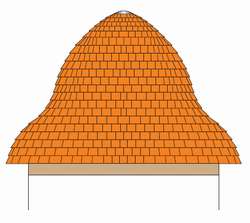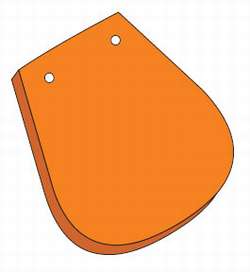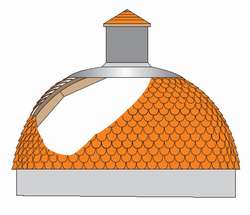Part-tiled roof showing substructure of dome
Dome tiles, or ‘fish-scale’ tiles should be used. These are semicircular at the tail and square at the top, with the sides tapered to absorb the horizontal curvature. The tiles have little or no camber. The size of the tiles in relation to the size of the dome is small so there should be little risk of tiles ‘riding’ on each another. The shaping of the tails compromises weather efficiency but the tiles are more flexible in use.
The pitch of the dome almost flattens out at the top of the roof so tiles here cannot provide any weather protection. Therefore a complete covering of lead or other metal is required to ensure adequate weather protection.
Such a covering, or cap, can be decorative, or in the form of a window detail to allow light into the dome.

![]()
Example of a Cupola roof
A Cupola is a small dome but at the critical roof pitch the dome rises to a peak to avoid the very low roof pitch angles. As the tiling reaches the apex normally the minimum side lap cannot be achieved and hence soakers will be required to maintain the weather tightness.
The roof groundwork can be a complex layer of‘plasterers laths’ laid obliquely; ie bent over all the curves to allow tile nails to be driven in anywhere on the curve.
Alternatively, 38 x 25mm battens could be used, amply ‘scarfed’ or otherwise treated to allow bending to the curves.

‘Dome’ or ‘fish-scale’ plain tile
Dome tiles, or ‘fish-scale’ tiles are semicircular at the tail and square at the top, with the sides tapered to absorb the horizontal curvature. The tiles have little or no camber. The size of the tiles in relation to the size of the dome is small so there should be little risk of tiles ‘riding’ up over each other. The shaping of the tails compromises weather efficiency but the tiles are more flexible in use.

